Ethical Issues at Workplace: Conflict Management Case Study
VerifiedAdded on 2022/10/08
|6
|1417
|27
Case Study
AI Summary
This case study examines a scenario involving sexual harassment in the workplace, where a vice president receives a report from an employee about a manager's inappropriate behavior towards a coworker. The student identifies their conflict management style as collaborating and discusses the legal implications, including the Civil Rights Act of 1964, the Violence Against Women Act of 1994, and the Whistleblowing Act. The study details a process for conducting a workplace investigation, emphasizing the importance of neutrality, confidentiality, and providing protection to the victim. It outlines steps such as appointing an investigator, developing a detailed investigation plan following EEOC guidelines, conducting interviews with all parties involved, and determining a resolution. The analysis highlights the need for a coordinated approach to address the ethical issue and ensure a fair outcome for all parties involved, and to take the employee's complaints seriously.
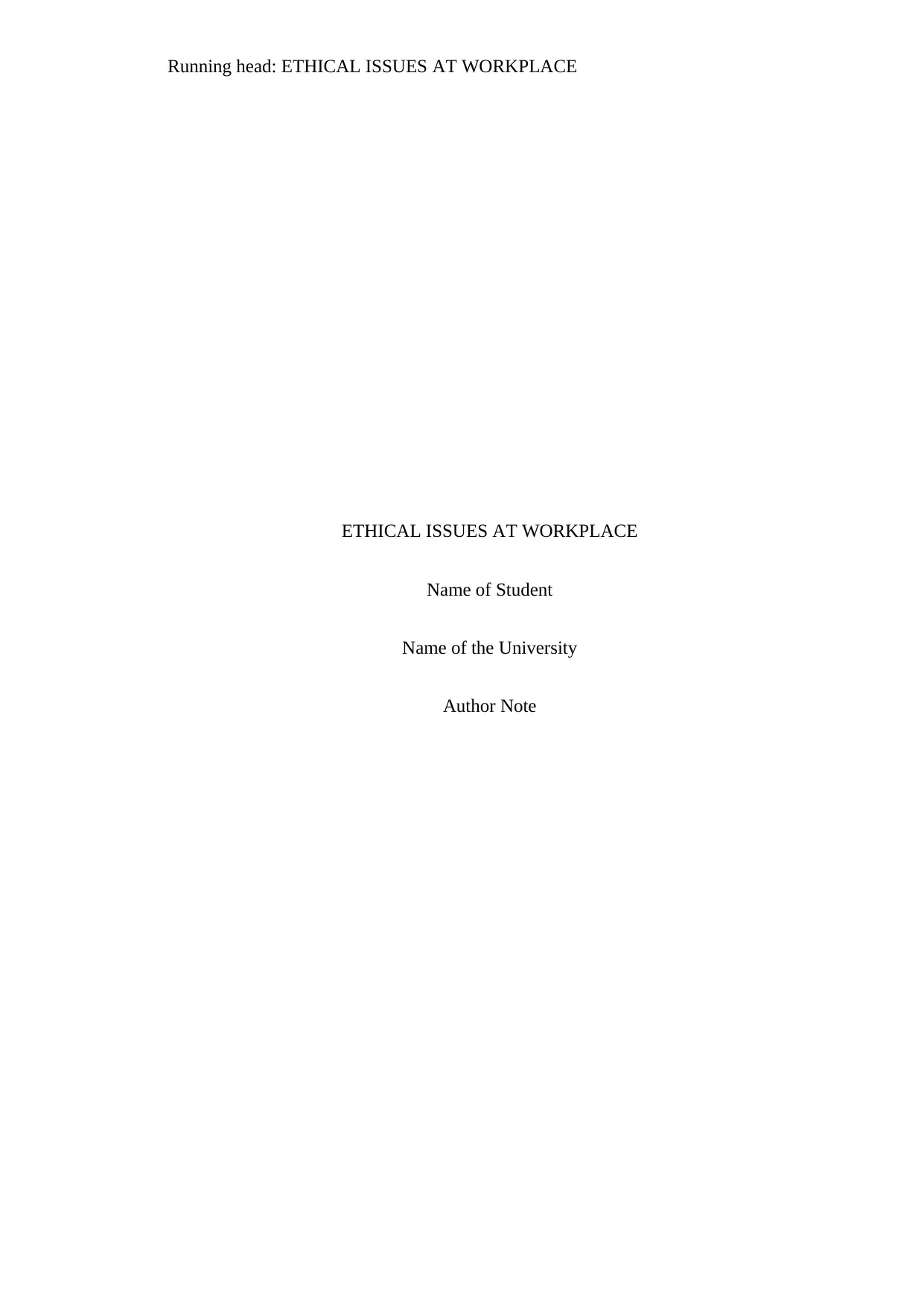
Running head: ETHICAL ISSUES AT WORKPLACE
ETHICAL ISSUES AT WORKPLACE
Name of Student
Name of the University
Author Note
ETHICAL ISSUES AT WORKPLACE
Name of Student
Name of the University
Author Note
Paraphrase This Document
Need a fresh take? Get an instant paraphrase of this document with our AI Paraphraser
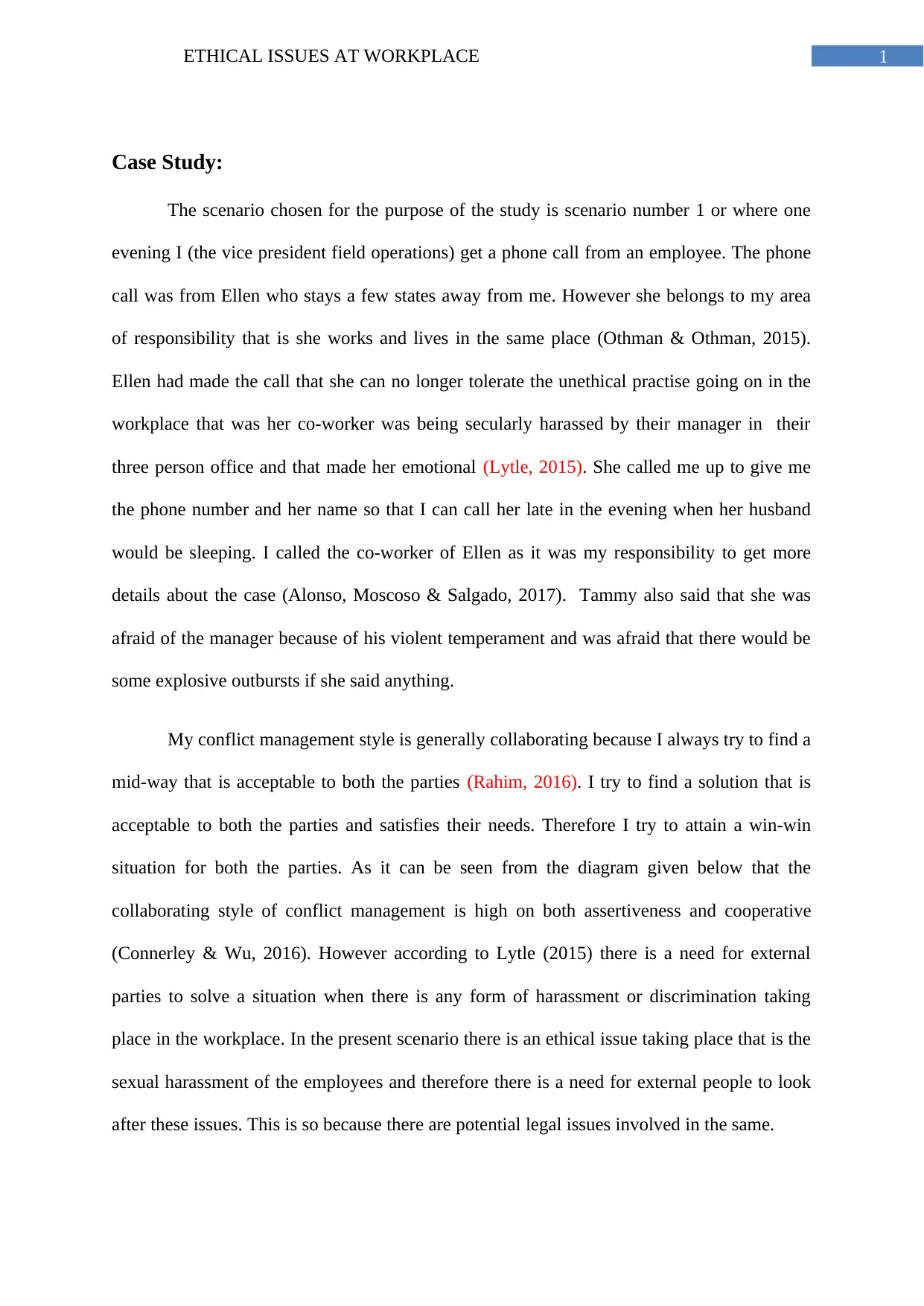
1ETHICAL ISSUES AT WORKPLACE
Case Study:
The scenario chosen for the purpose of the study is scenario number 1 or where one
evening I (the vice president field operations) get a phone call from an employee. The phone
call was from Ellen who stays a few states away from me. However she belongs to my area
of responsibility that is she works and lives in the same place (Othman & Othman, 2015).
Ellen had made the call that she can no longer tolerate the unethical practise going on in the
workplace that was her co-worker was being secularly harassed by their manager in their
three person office and that made her emotional (Lytle, 2015). She called me up to give me
the phone number and her name so that I can call her late in the evening when her husband
would be sleeping. I called the co-worker of Ellen as it was my responsibility to get more
details about the case (Alonso, Moscoso & Salgado, 2017). Tammy also said that she was
afraid of the manager because of his violent temperament and was afraid that there would be
some explosive outbursts if she said anything.
My conflict management style is generally collaborating because I always try to find a
mid-way that is acceptable to both the parties (Rahim, 2016). I try to find a solution that is
acceptable to both the parties and satisfies their needs. Therefore I try to attain a win-win
situation for both the parties. As it can be seen from the diagram given below that the
collaborating style of conflict management is high on both assertiveness and cooperative
(Connerley & Wu, 2016). However according to Lytle (2015) there is a need for external
parties to solve a situation when there is any form of harassment or discrimination taking
place in the workplace. In the present scenario there is an ethical issue taking place that is the
sexual harassment of the employees and therefore there is a need for external people to look
after these issues. This is so because there are potential legal issues involved in the same.
Case Study:
The scenario chosen for the purpose of the study is scenario number 1 or where one
evening I (the vice president field operations) get a phone call from an employee. The phone
call was from Ellen who stays a few states away from me. However she belongs to my area
of responsibility that is she works and lives in the same place (Othman & Othman, 2015).
Ellen had made the call that she can no longer tolerate the unethical practise going on in the
workplace that was her co-worker was being secularly harassed by their manager in their
three person office and that made her emotional (Lytle, 2015). She called me up to give me
the phone number and her name so that I can call her late in the evening when her husband
would be sleeping. I called the co-worker of Ellen as it was my responsibility to get more
details about the case (Alonso, Moscoso & Salgado, 2017). Tammy also said that she was
afraid of the manager because of his violent temperament and was afraid that there would be
some explosive outbursts if she said anything.
My conflict management style is generally collaborating because I always try to find a
mid-way that is acceptable to both the parties (Rahim, 2016). I try to find a solution that is
acceptable to both the parties and satisfies their needs. Therefore I try to attain a win-win
situation for both the parties. As it can be seen from the diagram given below that the
collaborating style of conflict management is high on both assertiveness and cooperative
(Connerley & Wu, 2016). However according to Lytle (2015) there is a need for external
parties to solve a situation when there is any form of harassment or discrimination taking
place in the workplace. In the present scenario there is an ethical issue taking place that is the
sexual harassment of the employees and therefore there is a need for external people to look
after these issues. This is so because there are potential legal issues involved in the same.
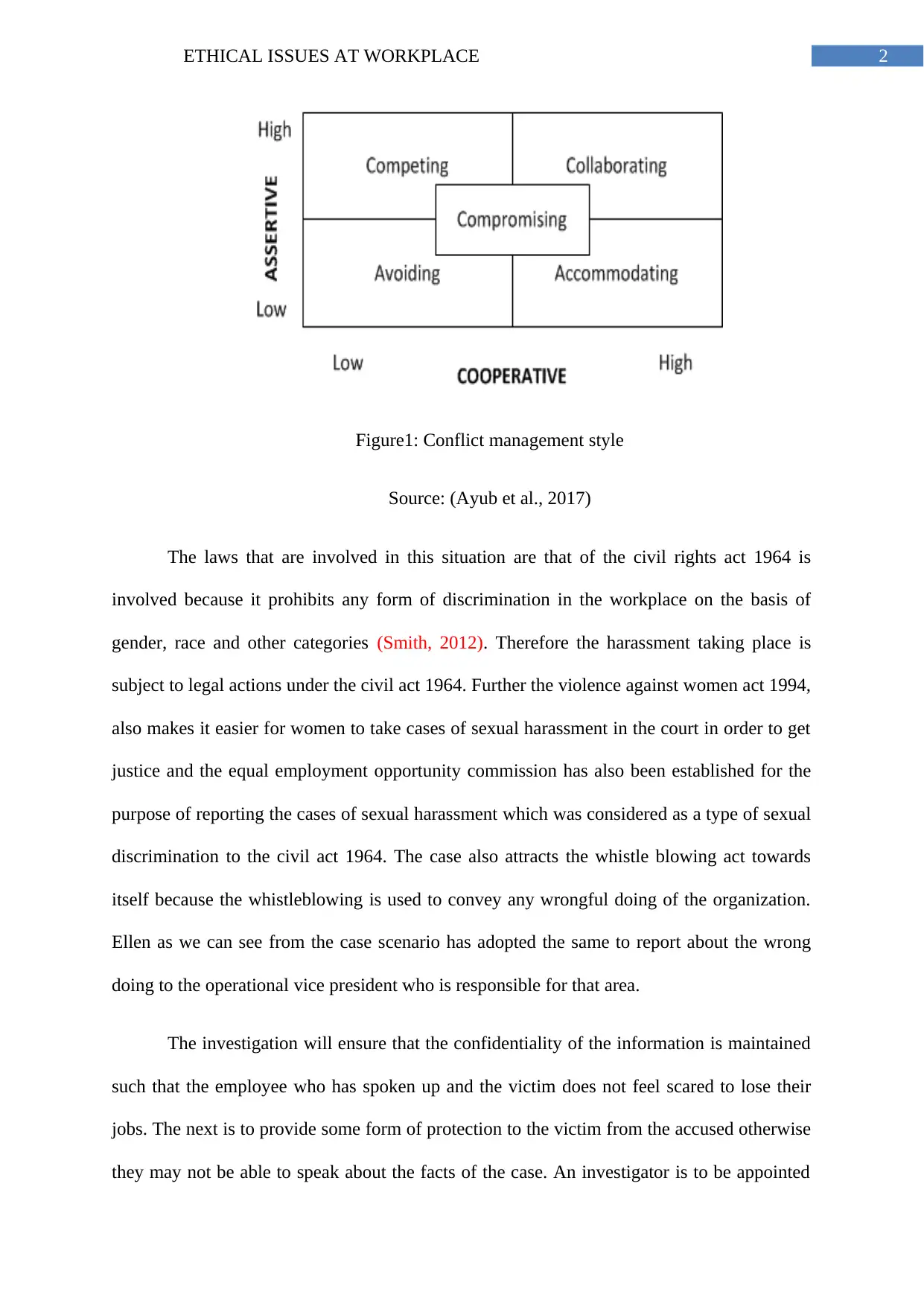
2ETHICAL ISSUES AT WORKPLACE
Figure1: Conflict management style
Source: (Ayub et al., 2017)
The laws that are involved in this situation are that of the civil rights act 1964 is
involved because it prohibits any form of discrimination in the workplace on the basis of
gender, race and other categories (Smith, 2012). Therefore the harassment taking place is
subject to legal actions under the civil act 1964. Further the violence against women act 1994,
also makes it easier for women to take cases of sexual harassment in the court in order to get
justice and the equal employment opportunity commission has also been established for the
purpose of reporting the cases of sexual harassment which was considered as a type of sexual
discrimination to the civil act 1964. The case also attracts the whistle blowing act towards
itself because the whistleblowing is used to convey any wrongful doing of the organization.
Ellen as we can see from the case scenario has adopted the same to report about the wrong
doing to the operational vice president who is responsible for that area.
The investigation will ensure that the confidentiality of the information is maintained
such that the employee who has spoken up and the victim does not feel scared to lose their
jobs. The next is to provide some form of protection to the victim from the accused otherwise
they may not be able to speak about the facts of the case. An investigator is to be appointed
Figure1: Conflict management style
Source: (Ayub et al., 2017)
The laws that are involved in this situation are that of the civil rights act 1964 is
involved because it prohibits any form of discrimination in the workplace on the basis of
gender, race and other categories (Smith, 2012). Therefore the harassment taking place is
subject to legal actions under the civil act 1964. Further the violence against women act 1994,
also makes it easier for women to take cases of sexual harassment in the court in order to get
justice and the equal employment opportunity commission has also been established for the
purpose of reporting the cases of sexual harassment which was considered as a type of sexual
discrimination to the civil act 1964. The case also attracts the whistle blowing act towards
itself because the whistleblowing is used to convey any wrongful doing of the organization.
Ellen as we can see from the case scenario has adopted the same to report about the wrong
doing to the operational vice president who is responsible for that area.
The investigation will ensure that the confidentiality of the information is maintained
such that the employee who has spoken up and the victim does not feel scared to lose their
jobs. The next is to provide some form of protection to the victim from the accused otherwise
they may not be able to speak about the facts of the case. An investigator is to be appointed
⊘ This is a preview!⊘
Do you want full access?
Subscribe today to unlock all pages.

Trusted by 1+ million students worldwide
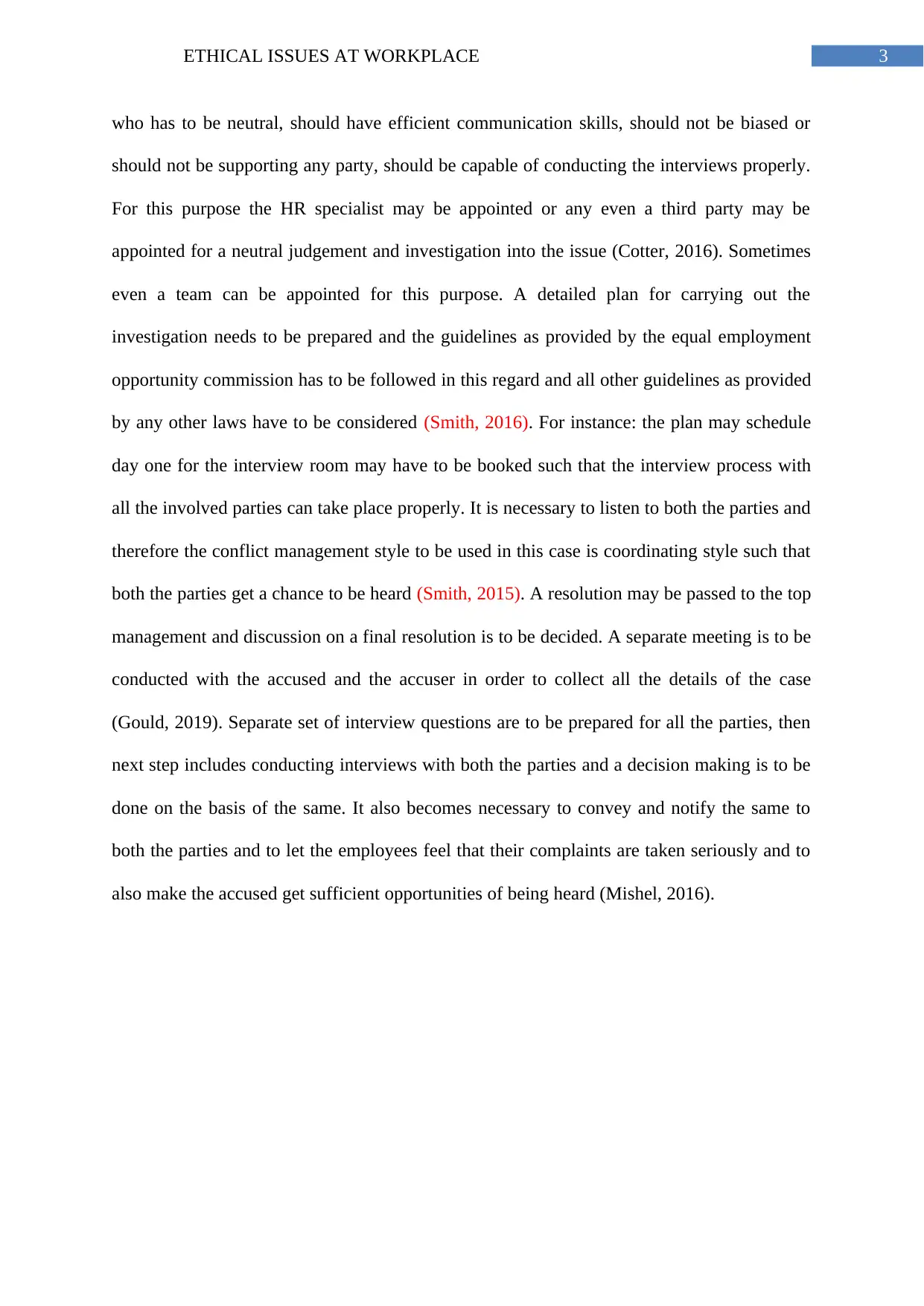
3ETHICAL ISSUES AT WORKPLACE
who has to be neutral, should have efficient communication skills, should not be biased or
should not be supporting any party, should be capable of conducting the interviews properly.
For this purpose the HR specialist may be appointed or any even a third party may be
appointed for a neutral judgement and investigation into the issue (Cotter, 2016). Sometimes
even a team can be appointed for this purpose. A detailed plan for carrying out the
investigation needs to be prepared and the guidelines as provided by the equal employment
opportunity commission has to be followed in this regard and all other guidelines as provided
by any other laws have to be considered (Smith, 2016). For instance: the plan may schedule
day one for the interview room may have to be booked such that the interview process with
all the involved parties can take place properly. It is necessary to listen to both the parties and
therefore the conflict management style to be used in this case is coordinating style such that
both the parties get a chance to be heard (Smith, 2015). A resolution may be passed to the top
management and discussion on a final resolution is to be decided. A separate meeting is to be
conducted with the accused and the accuser in order to collect all the details of the case
(Gould, 2019). Separate set of interview questions are to be prepared for all the parties, then
next step includes conducting interviews with both the parties and a decision making is to be
done on the basis of the same. It also becomes necessary to convey and notify the same to
both the parties and to let the employees feel that their complaints are taken seriously and to
also make the accused get sufficient opportunities of being heard (Mishel, 2016).
who has to be neutral, should have efficient communication skills, should not be biased or
should not be supporting any party, should be capable of conducting the interviews properly.
For this purpose the HR specialist may be appointed or any even a third party may be
appointed for a neutral judgement and investigation into the issue (Cotter, 2016). Sometimes
even a team can be appointed for this purpose. A detailed plan for carrying out the
investigation needs to be prepared and the guidelines as provided by the equal employment
opportunity commission has to be followed in this regard and all other guidelines as provided
by any other laws have to be considered (Smith, 2016). For instance: the plan may schedule
day one for the interview room may have to be booked such that the interview process with
all the involved parties can take place properly. It is necessary to listen to both the parties and
therefore the conflict management style to be used in this case is coordinating style such that
both the parties get a chance to be heard (Smith, 2015). A resolution may be passed to the top
management and discussion on a final resolution is to be decided. A separate meeting is to be
conducted with the accused and the accuser in order to collect all the details of the case
(Gould, 2019). Separate set of interview questions are to be prepared for all the parties, then
next step includes conducting interviews with both the parties and a decision making is to be
done on the basis of the same. It also becomes necessary to convey and notify the same to
both the parties and to let the employees feel that their complaints are taken seriously and to
also make the accused get sufficient opportunities of being heard (Mishel, 2016).
Paraphrase This Document
Need a fresh take? Get an instant paraphrase of this document with our AI Paraphraser
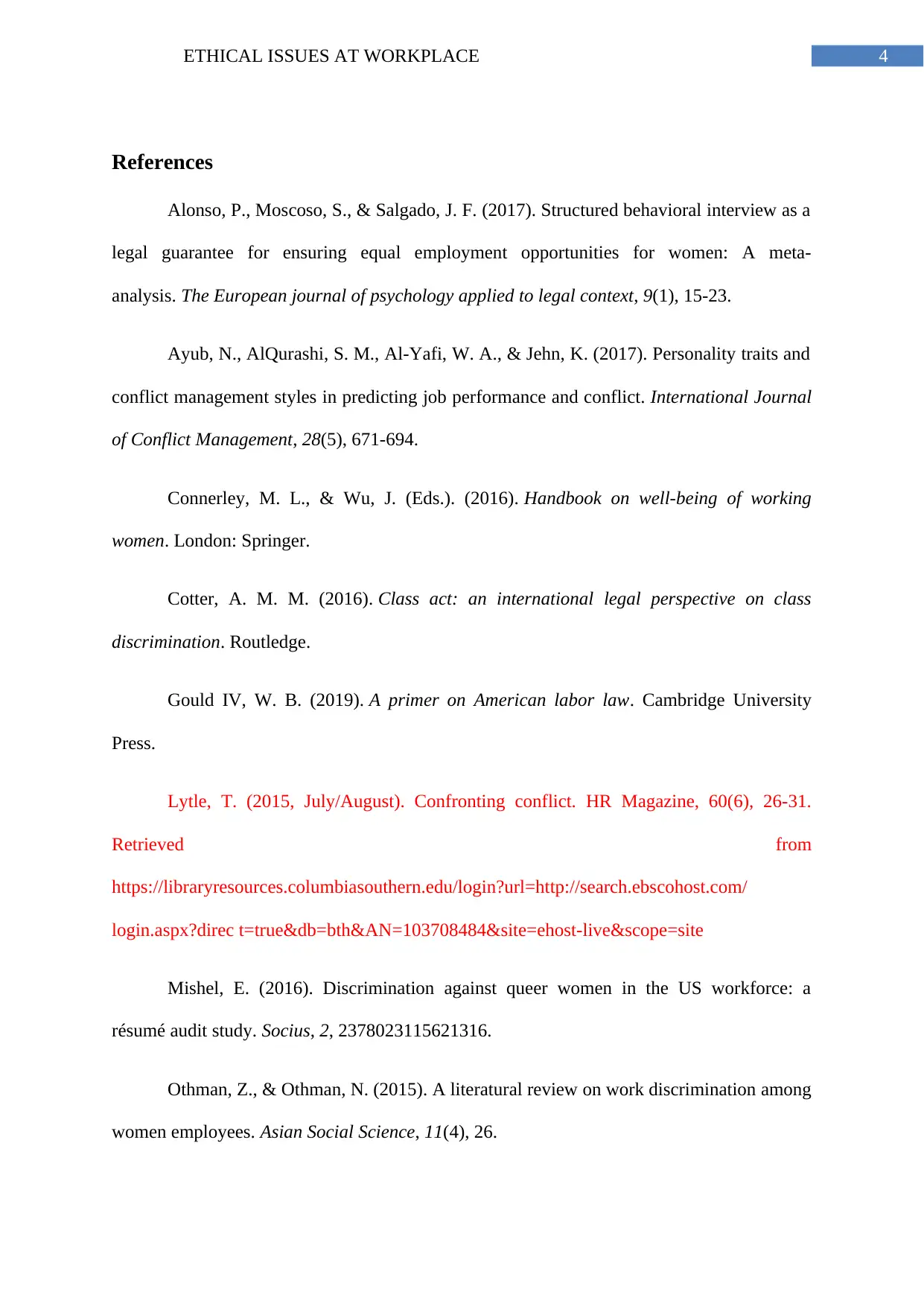
4ETHICAL ISSUES AT WORKPLACE
References
Alonso, P., Moscoso, S., & Salgado, J. F. (2017). Structured behavioral interview as a
legal guarantee for ensuring equal employment opportunities for women: A meta-
analysis. The European journal of psychology applied to legal context, 9(1), 15-23.
Ayub, N., AlQurashi, S. M., Al-Yafi, W. A., & Jehn, K. (2017). Personality traits and
conflict management styles in predicting job performance and conflict. International Journal
of Conflict Management, 28(5), 671-694.
Connerley, M. L., & Wu, J. (Eds.). (2016). Handbook on well-being of working
women. London: Springer.
Cotter, A. M. M. (2016). Class act: an international legal perspective on class
discrimination. Routledge.
Gould IV, W. B. (2019). A primer on American labor law. Cambridge University
Press.
Lytle, T. (2015, July/August). Confronting conflict. HR Magazine, 60(6), 26-31.
Retrieved from
https://libraryresources.columbiasouthern.edu/login?url=http://search.ebscohost.com/
login.aspx?direc t=true&db=bth&AN=103708484&site=ehost-live&scope=site
Mishel, E. (2016). Discrimination against queer women in the US workforce: a
résumé audit study. Socius, 2, 2378023115621316.
Othman, Z., & Othman, N. (2015). A literatural review on work discrimination among
women employees. Asian Social Science, 11(4), 26.
References
Alonso, P., Moscoso, S., & Salgado, J. F. (2017). Structured behavioral interview as a
legal guarantee for ensuring equal employment opportunities for women: A meta-
analysis. The European journal of psychology applied to legal context, 9(1), 15-23.
Ayub, N., AlQurashi, S. M., Al-Yafi, W. A., & Jehn, K. (2017). Personality traits and
conflict management styles in predicting job performance and conflict. International Journal
of Conflict Management, 28(5), 671-694.
Connerley, M. L., & Wu, J. (Eds.). (2016). Handbook on well-being of working
women. London: Springer.
Cotter, A. M. M. (2016). Class act: an international legal perspective on class
discrimination. Routledge.
Gould IV, W. B. (2019). A primer on American labor law. Cambridge University
Press.
Lytle, T. (2015, July/August). Confronting conflict. HR Magazine, 60(6), 26-31.
Retrieved from
https://libraryresources.columbiasouthern.edu/login?url=http://search.ebscohost.com/
login.aspx?direc t=true&db=bth&AN=103708484&site=ehost-live&scope=site
Mishel, E. (2016). Discrimination against queer women in the US workforce: a
résumé audit study. Socius, 2, 2378023115621316.
Othman, Z., & Othman, N. (2015). A literatural review on work discrimination among
women employees. Asian Social Science, 11(4), 26.
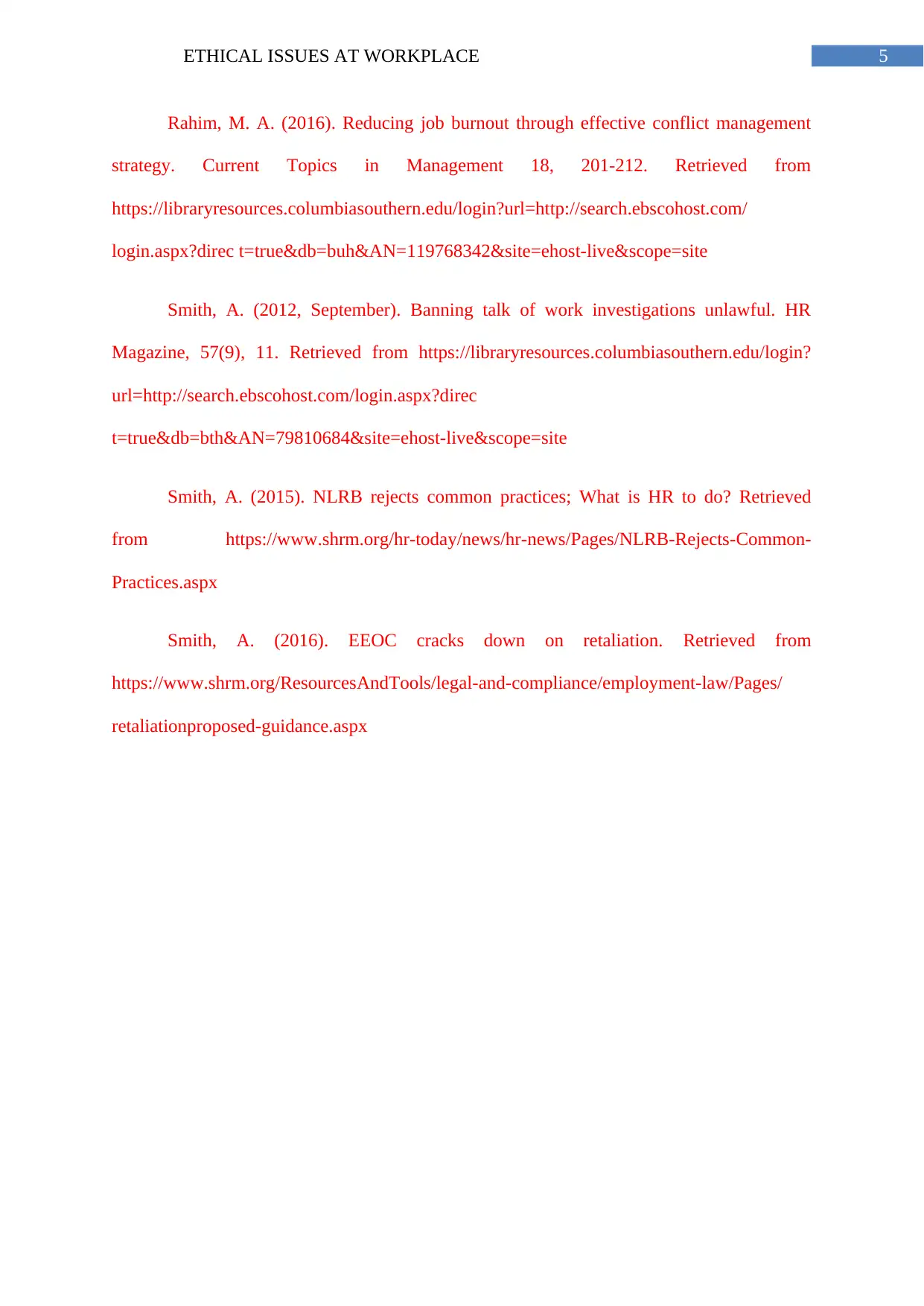
5ETHICAL ISSUES AT WORKPLACE
Rahim, M. A. (2016). Reducing job burnout through effective conflict management
strategy. Current Topics in Management 18, 201-212. Retrieved from
https://libraryresources.columbiasouthern.edu/login?url=http://search.ebscohost.com/
login.aspx?direc t=true&db=buh&AN=119768342&site=ehost-live&scope=site
Smith, A. (2012, September). Banning talk of work investigations unlawful. HR
Magazine, 57(9), 11. Retrieved from https://libraryresources.columbiasouthern.edu/login?
url=http://search.ebscohost.com/login.aspx?direc
t=true&db=bth&AN=79810684&site=ehost-live&scope=site
Smith, A. (2015). NLRB rejects common practices; What is HR to do? Retrieved
from https://www.shrm.org/hr-today/news/hr-news/Pages/NLRB-Rejects-Common-
Practices.aspx
Smith, A. (2016). EEOC cracks down on retaliation. Retrieved from
https://www.shrm.org/ResourcesAndTools/legal-and-compliance/employment-law/Pages/
retaliationproposed-guidance.aspx
Rahim, M. A. (2016). Reducing job burnout through effective conflict management
strategy. Current Topics in Management 18, 201-212. Retrieved from
https://libraryresources.columbiasouthern.edu/login?url=http://search.ebscohost.com/
login.aspx?direc t=true&db=buh&AN=119768342&site=ehost-live&scope=site
Smith, A. (2012, September). Banning talk of work investigations unlawful. HR
Magazine, 57(9), 11. Retrieved from https://libraryresources.columbiasouthern.edu/login?
url=http://search.ebscohost.com/login.aspx?direc
t=true&db=bth&AN=79810684&site=ehost-live&scope=site
Smith, A. (2015). NLRB rejects common practices; What is HR to do? Retrieved
from https://www.shrm.org/hr-today/news/hr-news/Pages/NLRB-Rejects-Common-
Practices.aspx
Smith, A. (2016). EEOC cracks down on retaliation. Retrieved from
https://www.shrm.org/ResourcesAndTools/legal-and-compliance/employment-law/Pages/
retaliationproposed-guidance.aspx
⊘ This is a preview!⊘
Do you want full access?
Subscribe today to unlock all pages.

Trusted by 1+ million students worldwide
1 out of 6
Your All-in-One AI-Powered Toolkit for Academic Success.
+13062052269
info@desklib.com
Available 24*7 on WhatsApp / Email
![[object Object]](/_next/static/media/star-bottom.7253800d.svg)
Unlock your academic potential
Copyright © 2020–2025 A2Z Services. All Rights Reserved. Developed and managed by ZUCOL.


